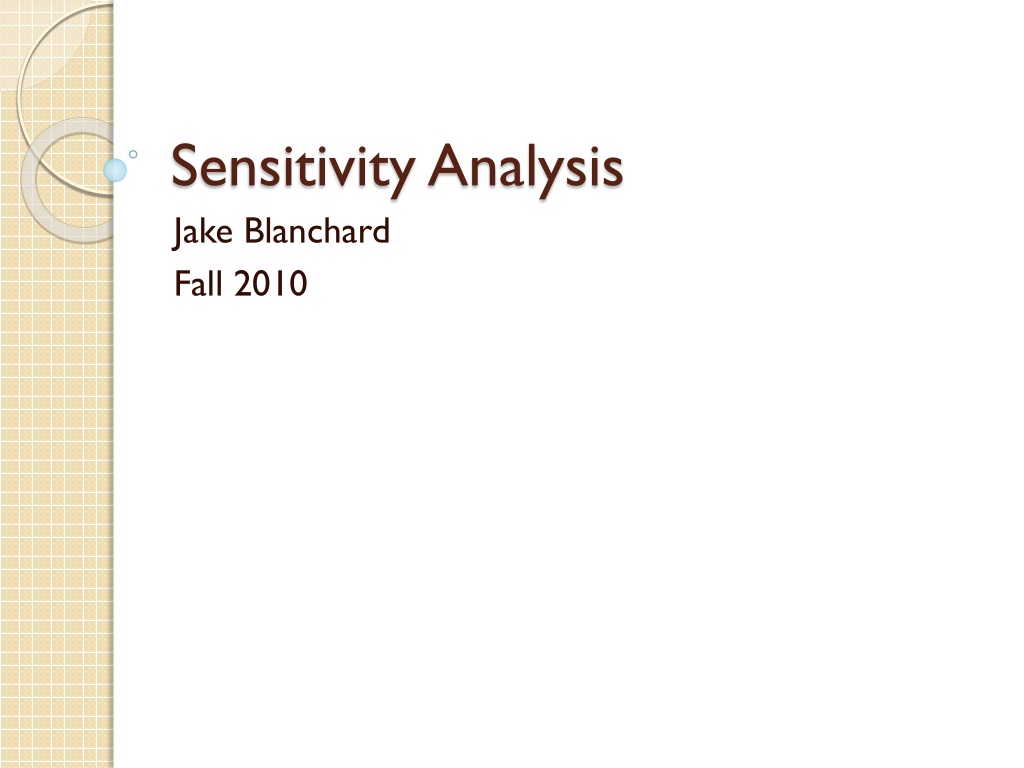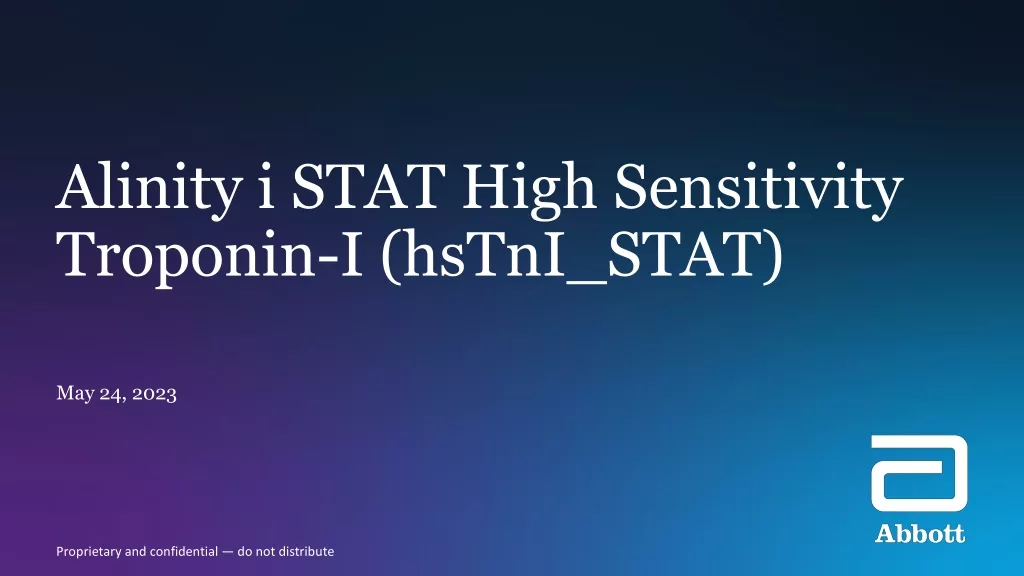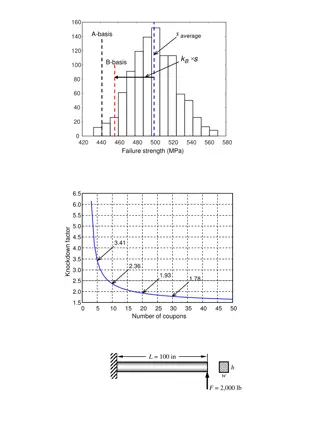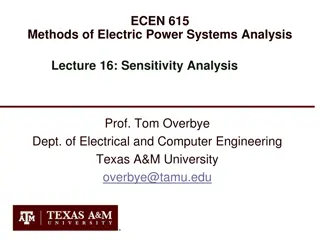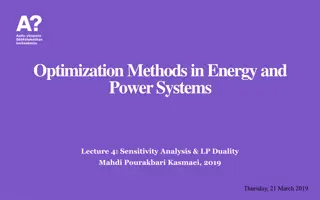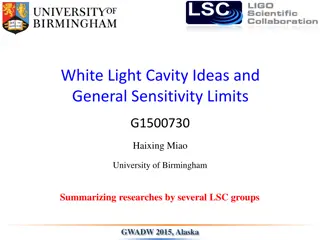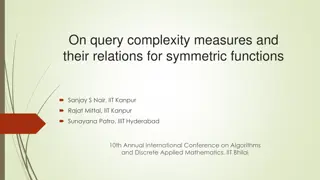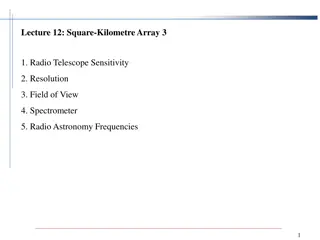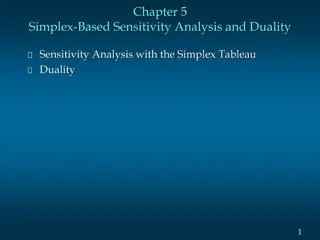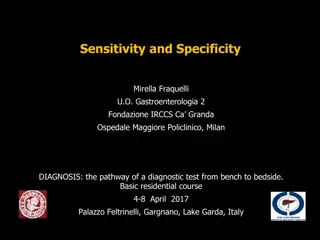Sensitivity Analysis
The study of how uncertainty in model outputs can be attributed to different input parameters, examining local and global sensitivity, illustrated with reactor kinetics problems and sensitivity measures.
Download Presentation

Please find below an Image/Link to download the presentation.
The content on the website is provided AS IS for your information and personal use only. It may not be sold, licensed, or shared on other websites without obtaining consent from the author.If you encounter any issues during the download, it is possible that the publisher has removed the file from their server.
You are allowed to download the files provided on this website for personal or commercial use, subject to the condition that they are used lawfully. All files are the property of their respective owners.
The content on the website is provided AS IS for your information and personal use only. It may not be sold, licensed, or shared on other websites without obtaining consent from the author.
E N D
Presentation Transcript
Sensitivity Analysis Jake Blanchard Fall 2010
Introduction Sensitivity Analysis = the study of how uncertainty in the output of a model can be apportioned to different input parameters Local sensitivity = focus on sensitivity at a particular set of input parameters, usually using gradients or partial derivatives Global or domain-wide sensitivity = consider entire range of inputs
Typical Approach Consider a Point Reactor Kinetics problem 1.8 =0.08 increased by 50% dP 1.7 = + 0 ( ) ( ) P t C t dt 1.6 dC 1.5 = ( ) ( ) P t C t P(t) 1.4 dt = = P 1.3 ) 0 ( P 1 P 0 1.2 = 0 ) 0 ( C 1.1 1 0 0.5 1 1.5 2 2.5 3 time (s)
Results P(t) normalized to P0 Mean lifetime normalized to baseline value (0.001 s) t=3 s 2 -3 3x 10 1 relative change in P(t) 0 -1 -2 -3 -0.1 -0.05 0 0.05 0.1 0.15 relative change in
Results P(t) normalized to P0 Mean lifetime normalized to baseline value (0.001 s) t=0.1 s 0.015 0.02 0.01 relative change in P(t) 0.005 0 -0.005 -0.01 -0.015 -0.1 -0.05 0 0.05 0.1 0.15 relative change in
Putting all on one chart t=0.1 s 0.025 0 0.02 0.015 dimensionless variation in P(t) 0.01 0.005 0 -0.005 -0.01 -0.015 -0.02 -0.025 -0.2 -0.15 -0.1 dimensionless variation in input variable -0.05 0 0.05 0.1 0.15
Putting all on one chart t=3 s 0.15 0 0.1 dimensionless variation in P(t) 0.05 0 -0.05 -0.1 -0.15 -0.2 -0.2 -0.15 -0.1 dimensionless variation in input variable -0.05 0 0.05 0.1 0.15
Quantifying Sensitivity To first order, our measure of sensitivity is the gradient of an output with respect to some particular input variable. Suppose all variables are uncertain and + + = Y C P C P C P s s t t j j Then, if inputs are independent, C P C Y + = = + + P C P s s t t j j + y C p C p C p s s t t j j = + + 2 y 2 s 2 s 2 t 2 t 2 j 2 j C C C
Quantifying Sensitivity Most obvious calculation of sensitivity is Y S = x P x This is the slope of the curves we just looked at We can normalize about some point (y0) = + + 0 0 0 0 y C p C p C p s s t t j j 0 p Y = l x x 0 S y P x
Quantifying Sensitivity This normalized sensitivity says nothing about the expected variation in the inputs. If we are highly sensitive to a variable which varies little, it may not matter in the end Normalize to input variances Y = x S x P y x
Rewriting Y = = s s S C s s P y s y = t S C t t y j = S C j j y = + + 2 s 2 s 2 t 2 t 2 j 2 j C C C y 2 j 2 s 2 t = + + 2 s 2 t 2 j 1 C C C 2 y 2 y 2 y
A Different Approach Question: If we could eliminate the variation in a single input variable, how much would we reduce output variation? Hold one input (Px) constant Find output variance V(Y|Px=px) This will vary as we vary px So now do this for a variety of values of pxand find expected value E(V(Y|Px)) Note: V(Y)=E(V(Y|Px))+V(E(Y|Px))
Now normalize ( ( | )) V E Y P = x S x V y This is often called the importance measure, sensitivity index, correlation ratio, or first order effect
Variance-Based Methods Assume ( ) k ( ) x ( ) = = = + + + + ( ) , ... , ,..., Y f x f f f x x f x x x 0 2 , 1 ,..., 1 2 i i ij i j k k 1 i i j i Choose each term such that it has a mean of 0 Hence, f0is average of f(x) ( ) ( ( , , x Y E x x f i j i ij = ) = f x E Y x f 0 i i i ( ) ) ( ) x ( ) x x f f f 0 j i i j j
Variance Methods Since terms are orthogonal, we can square everything and integrate over our domain ( ) x Y E i V i | = = 2 k = + + + + ... V V V V V 2 , 1 ,..., f i ij ijk k 1 i i j i j k ( ) x = 2 V f dx i i i i V = i S i V f k = = + + + + 1 ... S S S S 2 , 1 ,..., i ij ijk k 1 i i j i j k
Variance Methods Siis first order (or main) effect of xi Sijis second order index. It measures effect of pure interaction between any pair of output variables Other values of S are higher order indices Typical sensitivity analysis just addresses first order effects An exhaustive sensitivity analysis would address other indices as well
Suppose k=4 1=S1+S2+S3+S4+S12+S13+S14+S23+S24+S34+ S123+S124+S134+S234+S1234 Total # of terms is 4+6+4+1=15=24-1
